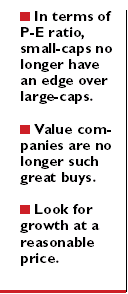Article
Investment Consult
The next hot sector? Think large.

That's why I've started paying a lot more attention to large-cap stocks and mutual funds. For the past two years, small- and mid-cap companies have passed large-caps like left-lane drivers cruising past Sunday sightseers. And when the market dropped from early 2000 to late 2002, large-caps had the longest, biggest fall, while mid-caps and small-caps fared much better.
But it looks like the smaller companies' relative momentum could start to peter out, while large-caps are getting ready to gain speed. I wouldn't go as far as to call small-caps overpriced, but in terms of price-to-earnings ratio (P-E), they no longer have an edge over large-caps.
Large companies often give your portfolio an international dimension, too. Companies like Cisco Systems and Microsoft have offices around the world and derive a significant portion of their income from overseas sales. With the decline of the dollar, US companies that operate abroad have an edge in selling US-made products.
And whether we like it or not, outsourcing is a big factor for many large companies. It enables them to take advantage of cheaper wages abroad, which ultimately helps their bottom line.
Privatizing Social Security might also bode well for large-cap stocks. If it does happen, it's likely that the portfolios available to investors would include mostly plain-vanilla large-cap funds. That would bring a surge of new money into the S&P 500 companies, which would probably boost their share prices.
But don't get me wrong: I'm not chomping at the bit to snap up just any large company stock or mutual fund. I'm lukewarm about pure value companies-those whose prices are low due to temporary setbacks or unfavorable market conditions. As investors recognized their allure, their P-Es rose, making them less of a bargain. Because of this, I'm charting a midway course, steering clear of overpriced companies and looking to large companies that offer growth at a reasonable cost. Wal-Mart Stores and Johnson & Johnson are two that currently fit the bill.
I'm advising some of my clients to sell a portion of their small- and mid-cap holdings, and put the proceeds into large-caps. For clients whose small- and mid-cap assets combined are greater than their large-cap assets, I've cut back on the small- and mid-caps so that they equal, or are smaller than, the large-cap proportion.
Rather than choosing individual stocks, I'm buying mutual funds. I like the Oakmark Fund - Class I Shares (800-625-6275), which has a strong long-term record. I recently spoke with Bill Nygren, one of the portfolio managers. He concentrates primarily on value stocks, but his choices lean to the more-reasonable end of growth and include McDonald's, Time Warner, and Home Depot. The fund's annualized returns have beaten the S&P 500's over the past one and three years: 7.7 and 4.0 percent respectively. (Unless otherwise indicated, all returns are through March 31.)





